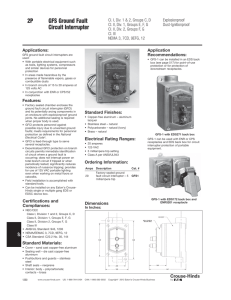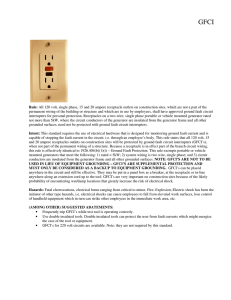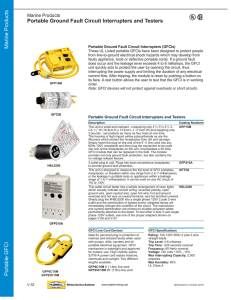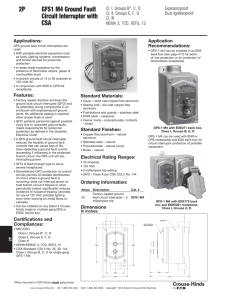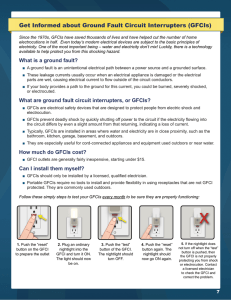Ground Fault Protection - Harleysville Insurance
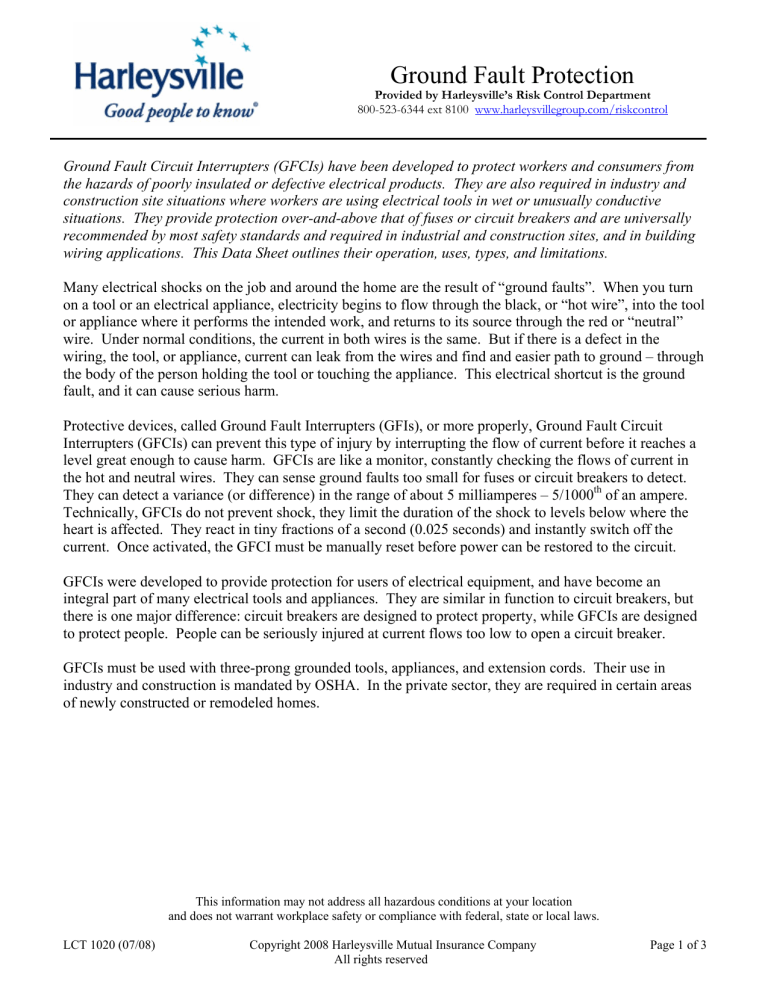
Ground Fault Protection
Provided by Harleysville’s Risk Control Department
800-523-6344 ext 8100 www.harleysvillegroup.com/riskcontrol
Ground Fault Circuit Interrupters (GFCIs) have been developed to protect workers and consumers from the hazards of poorly insulated or defective electrical products. They are also required in industry and construction site situations where workers are using electrical tools in wet or unusually conductive situations. They provide protection over-and-above that of fuses or circuit breakers and are universally recommended by most safety standards and required in industrial and construction sites, and in building wiring applications. This Data Sheet outlines their operation, uses, types, and limitations.
Many electrical shocks on the job and around the home are the result of “ground faults”. When you turn on a tool or an electrical appliance, electricity begins to flow through the black, or “hot wire”, into the tool or appliance where it performs the intended work, and returns to its source through the red or “neutral” wire. Under normal conditions, the current in both wires is the same. But if there is a defect in the wiring, the tool, or appliance, current can leak from the wires and find and easier path to ground – through the body of the person holding the tool or touching the appliance. This electrical shortcut is the ground fault, and it can cause serious harm.
Protective devices, called Ground Fault Interrupters (GFIs), or more properly, Ground Fault Circuit
Interrupters (GFCIs) can prevent this type of injury by interrupting the flow of current before it reaches a level great enough to cause harm. GFCIs are like a monitor, constantly checking the flows of current in the hot and neutral wires. They can sense ground faults too small for fuses or circuit breakers to detect.
They can detect a variance (or difference) in the range of about 5 milliamperes – 5/1000 th
of an ampere.
Technically, GFCIs do not prevent shock, they limit the duration of the shock to levels below where the heart is affected. They react in tiny fractions of a second (0.025 seconds) and instantly switch off the current. Once activated, the GFCI must be manually reset before power can be restored to the circuit.
GFCIs were developed to provide protection for users of electrical equipment, and have become an integral part of many electrical tools and appliances. They are similar in function to circuit breakers, but there is one major difference: circuit breakers are designed to protect property, while GFCIs are designed to protect people. People can be seriously injured at current flows too low to open a circuit breaker.
GFCIs must be used with three-prong grounded tools, appliances, and extension cords. Their use in industry and construction is mandated by OSHA. In the private sector, they are required in certain areas of newly constructed or remodeled homes.
LCT 1020 (07/08)
This information may not address all hazardous conditions at your location and does not warrant workplace safety or compliance with federal, state or local laws.
Copyright 2008 Harleysville Mutual Insurance Company
All rights reserved
Page 1 of 3
Types of Ground Fault Installations
Ground Fault protection comes in a variety of devices and may be installed at different locations within a circuit.
1.
Circuit Breaker /GFCI – These units are located at the power supply or in a circuit breaker panel controlling all outlets in a circuit. They have a dual purpose in this configuration: they shut-off power in the event of a “ground fault”, but they will also trip when a short circuit or an overload occurs.
They protect the wiring and each outlet served on the common branch of that circuit.
2.
Ground Fault Receptacles – Direct-wired ground fault circuit interrupter receptacles, or Ground Fault
Receptacles provide a ground fault protection at the point of installation. They are installed in the standard outlet box and protects against “ground faults” whenever an electrical tool is plugged-into the outlet. They may be installed to provide ground fault protection to all other receptacles installed downstream on the same circuit.
3.
Portable GFCIs – Where permanent GFCIs are not practical, portable units can be used. One type contains the GFCI circuitry in a plastic enclosure with plug and receptacle slots in the front. The portable GFCI is plugged into a standard receptacle; then the cord from the electrical tool or appliance is plugged into the GFCI outlet. Another type of portable GFCI is an extension cord combined with a
GFCI. It adds flexibility in using receptacles that are not protected by GFCIs.
GFCI devices and circuitry are increasingly being designed into an increasing number of tools, appliances, and equipment. They also come in Standard and Hospital-grade GFCI sensitivities.
GFCI Limitations
GFCI circuitry has certain inherent limitations that will cause them to open the circuit inappropriately.
These conditions are called: Capacitive Coupling and Spurious Signals. Capacitive Coupling occurs when long cables are buried in the earth, and the top and bottom parts of the cable act like the plates of a capacitor. This allows tiny current leaks to occur along the length of the cable. These tiny discharges can open the GFCI. This is one reason that it is advantageous to locate the GFCI as close as possible to the electrical load. Spurious Signals occurs when the electrical load of a circuit is changed suddenly due to turning on or off various electrical devices – especially all at once. The sudden change unbalances the current input (black wire) and output (red wire) and the GFCI trips.
Recent Developments
Technology changes in the last 10 years have brought about a variety of similar, but more specialized devices. These include:
1.
Appliance Leakage Current Interrupters (ALCIs)
2.
Equipment Leakage Current Interrupters (ELCIs), and
3.
Immersion Detection Circuit Interrupters (IDCIs)
ALCIs and ELCIs are devices that react at less than 5 milliamps to interrupt power. ALCIs are considered personal protective equipment, and not intended to replace GFCIs. ELCIs are equipment protection devices are intended for sensitive equipment. Immersion Detection devices (IDCIs) are inserted into appliances and are designed to protect people as their name suggests. Its chief virtue is that it is designed to function independently of a grounded object. They are not intended to replace CFCIs .
LCT 1020 (07/08)
This information may not address all hazardous conditions at your location and does not warrant workplace safety or compliance with federal, state or local laws.
Copyright 2008 Harleysville Mutual Insurance Company
All rights reserved
Page 2 of 3
Related Information:
1.
National Fire Protection Association (NFPA) - National Electrical Code – NFPA #70, Section 210-8 of
Specifies that all remodeling and new construction dealing with certain kitchen, garage, basement, bathroom, and outdoor receptacles should be protected with Ground Fault Circuit Protection.
2.
OSHA 1910.304 – General Industry and 1926.404 – Construction - These codes require GFCI protection. [120 volt, single phase, 15 and 20 ampere receptacle outlets on construction sites, which are not part of the permanent wiring of the building or structure, and which are in use by employees, shall have approved ground fault circuit interrupters for personal protection.]
3.
OSHA Outreach training program – http://www.osha-slc.gov/doc/outreachtraining/htmlfiles/gfcicon.html
The information and suggestions contained in this data sheet have been developed from sources believed to be reliable. However, we accept no legal responsibility for the correctness or completeness of this material or its application to specific factual situations.
LCT 1020 (07/08)
This information may not address all hazardous conditions at your location and does not warrant workplace safety or compliance with federal, state or local laws.
Copyright 2008 Harleysville Mutual Insurance Company
All rights reserved
Page 3 of 3
